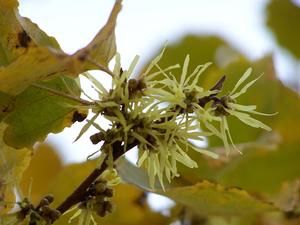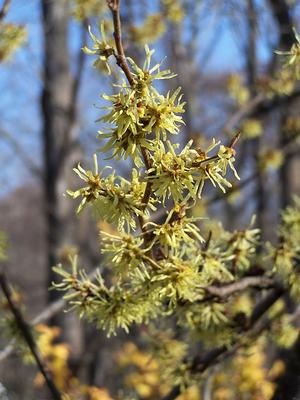Hamamelis virginiana: Eastern Witchhazel
Autumn flowering Eastern Witchhazel, also known as Common Witchhazel, is the laudable Hamamelis virginiana. Long used as a medicinal astringent Reverend Thomas Newton Dickinson processed the first commercial pure extract in the early 1800s right here in Connecticut. Because of its many uses Dickinson's Witch Hazel quickly found adherents becoming an American tradition. Dickinson's Witch Hazel, popular yet, is still available and produced in its pure botanical form in East Hampton, Connecticut.
Common Witchhazel is anything but common being a great native shrub that is finally garnering some well-deserved respect as a worthy ornamental. Its range extends to most of the eastern half of North America. Hamamelis virginiana may grow as tall as 15 to 20 feet, more upright than wide. Larger selections, excepting 'Little Suzie', can be formed into single stem small trees entirely dependent upon how you may employ your pruning shears.
Attractive medium to dark green leaves unfurl in spring on smooth gray to grayish brown bark. The elliptic to broadly ovate alternate leaves are irregularly and coarsely toothed. Leaves are narrower near the leaf stems and broaden out in varying widths towards centers and tips. The foliage matures with a satin sheen and remains handsome all through the growing season. In autumn leaves become a beautiful butter yellow while the strap-shaped crepe petals, four per flower, unfurl in the same bright yellow color in most selections. Eastern Witchhazel can bloom from at least two to as many five weeks, weather dependent. Autumn foliage color and its late bloom, up to Thanksgiving and beyond, make it a most-worthy candidate for extended garden interest.
LITTLE SUZIE
'Little Suzie' is a marvelous dwarf form only growing 4 to 5 feet tall and wide in a decade. It has typical profuse full-sized yellow flowers in mid to middle-late autumn. Because of its small size 'Little Suzie' will fit nicely into the smaller garden, a foundation planting or as a smaller forwardly-placed element in a larger shrub border. Its smaller size would make it a candidate for bonsai. Yellow flowers occur with the same autumn foliage tones but its easy to see blossoms when one peers into the shrub from above.
HARVEST MOON
One issue that gardeners have had with Eastern Witchhazel is that its flowers are the same color as its autumn leaves. And with both yellow leaves and flowers occurring simultaneously its foliage masks, and indeed, can camouflage the flowers. But 'Harvest Moon', introduced by Dick Jaynes at Broken Arrow Nursery in Hamden, CT, changes the timing equation; it is a later-to-bloom selection with slightly larger flowers. The beautiful bright yellow autumn leaves drop leaving its pretty exposed flowers on full display. 'Harvest Moon' is fully in flower here at Quackin' Grass on Thanksgiving and in some years into early December.
GREEN THUMB
'Green Thumb' sports a very broad, irregular golden green leaf margin with a darker, lustrous green interior. It is a lovely form well-suited to a part shade siting where the foliage will light up all through the growing season. We love that its irregularly-formed leaves display varying widths of lighter greenish golden edges; no two leaves are alike. Typical autumn yellow flowers only add to its appeal and also glow in light shade. 'Green Thumb' appears to be an intermediate grower, shorter than the large selections but taller than 'Little Suzie' by many feet.
MOHONK RED
'Mohonk Red' ups the ornamental ante once again. As its name suggests the spidery crepe flowers are a pretty light red with each petal tipped in yellow. And though the autumn leaves and flowers tend to occur together in rhapsodic choral climax the contrast between the red flowers and yellow leaves is resplendent. Reports of red-flowering Eastern Witchhazels circulated for more than a century. 'Mohonk Red' was eventually found in the Mohonk Nature Preserve in New York state. We do not know who may have finally introduced it but we are grateful that 'Mohonk Red' is now available to gardeners.
Plant Hamamelis virginiana in fertile, moisture retaining soils for best results. Though tolerant of open shade and woodland conditions a denser and probably more heavy-flowered shrub will be had in full sun. Native Eastern Witchhazel is bone hardy for us in Connecticut, USDA climate zone 4 (-30F). Some plants of far northern provenance are hardy to -35F.
For a marvelous late season display consider a combination of Common Witchhazel with crabapple plus Zenobia pulverulenta that holds onto its brilliantly colored autumn leaves well into December. Viburnum dilatatum 'Erie' (red-fruited) and 'Michael Dodge' (pale yellow berries) with red and orange autumn leaves would stand in striking contrast. Winterberries with red, pale orange or golden berries would pair handsomely. Set any of the possibilities with a ground cover of late blooming hardy mums for a complete, gorgeous and heart warming mid to late autumn explosion before the long winter arrives.
penned by Wayne Paquette, February 2012

Hamamelis virginiana 'Harvest Moon' is a Broken Arrow Nursery introduction
